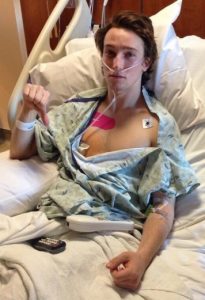Freeskier Torin Yater-Wallace gives a thumbs down in the St. Anthony Summit Medical Center in Frisco, Colorado, on November 29, 2013, during recovery from surgery to treat a pneumothorax that he suffered after a physical therapist punctured his right lung with an acupuncture needle.
All needle therapies are invasive procedures that require the practitioner to have extensive training in order to ensure patient safety. Serious injuries can and have occurred from patients receiving treatment from practitioners with inadequate training.
There is at least one documented case in Georgia of a fifteen year girl being dry needled without parental consent who collapsed after treatment. While we are also aware of another case of a physical therapist in GA causing a pneumothorax, the patient has not yet come forward to report the case and the physical therapist who caused the injury has left Georgia. A third case is likely to settle out of court and will likely remain closed to the public.
Some states have even banned physical therapists from practicing dry needling due to public safety concerns. Needle length can range up to 4-5 inches in order to reach the affected muscles. Dry needling presents a substantial threat to public safety when performed without adequate education, training, and independent competency examination. The patient can develop painful bruises after the procedure and adverse reactions may include hematoma, pneumothorax (lung puncture), nerve injury, vascular injury and infection.
An ill-trained practitioner could, as a result of inadequate education or lack of experience, cause substantial medical injury. Even an acupuncturist or physician could cause an injury though the many years of required training and supervised clinical practice make this far less likely than when one begins practicing with only 1-2 weekends of training.
Read about other documented cases of dry needling injury here.
